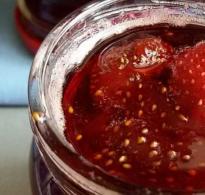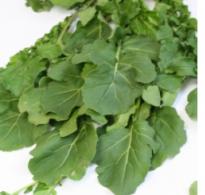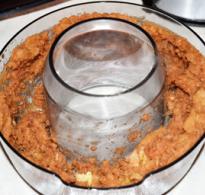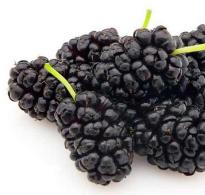Homemade adjika with horseradish recipe. Adjika with tomatoes, garlic and horseradish: subtleties of preparation
Many dishes are popular among the residents of our country. But every family prepares them a little differently. Previously recipes favorite dishes were passed on to each other in words or written on pieces of paper. Now each of us has access to the World Wide Web, and every woman can experiment to her heart’s content in her kitchen, relying on the experience of other housewives. Great option For such experiments there will be preparations for the winter. And one of them is adjika with horseradish and tomatoes without cooking, as well as with horseradish and garlic.
Adjika without cooking with horseradish and tomatoes
To prepare such a preparation for the winter, you need to prepare two kilograms of red tomatoes, four hundred grams of horseradish root and two hundred grams of garlic. You will also need a couple of tablespoons of salt, one hundred and fifty grams of sugar and fifteen red sweet peppers. In addition, use two hot peppers and two hundred grams of vinegar. From this volume of products you should get three liters of adjika.
Scald the tomatoes with boiling water, cool and peel them. Peel the horseradish root and chop into small pieces. Salad pepper remove seeds and cut into medium strips. Peel the garlic and cut off the stem from the hot pepper.
Grind all prepared ingredients through a meat grinder. Add salt, sugar and vinegar to them. Mix the resulting mixture thoroughly and leave it for twelve hours in a cool place. Pour adjika into clean steamed jars, seal and store in the refrigerator.
Adjika with tomatoes and horseradish without cooking. Second recipe with greens
To prepare such a dish, you need to prepare two kilograms of tomatoes, ten bell peppers, five hot peppers, eight heads of garlic and one hundred grams of horseradish. In addition, use four hundred grams of parsley and two hundred grams of dill. You will also need twenty-five to thirty-five grams of salt.
Wash and peel the vegetables. Sweet pepper grind and remove the seeds from it. Cut the hot pepper, remove the seeds with partitions, and then do not forget to wash your hands thoroughly.
Peel the garlic, peel the horseradish root and chop into arbitrary pieces. Chop the tomatoes and chop the greens into smaller pieces.
Grind the tomatoes, peppers, garlic and horseradish root through a meat grinder. Stir the greens into the prepared mixture, add salt and stir well. Place the adjika into sterilized jars, seal and store in the refrigerator.
Adjika with horseradish and tomatoes without cooking
To prepare this option raw adjika you don't need vinegar or bell peppers. Stock up on three kilograms of tomatoes, two hundred grams of horseradish root, three to four heads of garlic, four to five hot peppers and three tablespoons of salt (depending on your taste preferences).
Wash the tomatoes and cut into two to four parts. Cut out the stem from them. Pour water over the horseradish roots and leave for one hour. Wash them. Peel the garlic. Wash and peel the hot pepper. Pass all components through a meat grinder, mix and add salt to taste.
Place the finished adjika in clean, dry jars, cover nylon covers and store in the refrigerator.
Adjika without cooking with horseradish and garlic
For this preparation you need to prepare twelve glasses of fresh tomato juice, a kilogram of bell pepper, a glass of chopped garlic, a glass grated horseradish. Also use one hundred milliliters table vinegar(9%), one hundred grams of sugar and some salt (depending on your taste preferences).
Prepare the juice of ripe red tomatoes in advance. To get twelve glasses of this juice, you need to use about five kilograms of tomatoes. Also wash the peppers, garlic and horseradish root in advance. Dry them and clean them. Wash the pepper, core it and cut it into four to six pieces. Crank all components in a meat grinder. Add all the spices to the resulting mass, mix and place in jars. Store adjika in the cold.
Raw adjika with horseradish and garlic without cooking, which will be stored for a long time
To prepare such a preparation, stock up on three kilograms of tomatoes, one kilogram of bell pepper, two to four hot peppers, two heads of garlic, salt and aspirin. For ten liters of finished adjika you need to use forty aspirin tablets.
To prepare a particularly tasty preparation, it is better to give preference to very red and fleshy tomatoes, as well as fleshy bell peppers.
Wash the vegetables and dry. Grind them into small pieces, remove the stems and core. Grind the prepared vegetables through a meat grinder. Mix salt and crushed aspirin into the resulting mass. Mix well, pour into sterilized jars, seal with tight lids and store for a long time. cool place.
The benefits of adjika
Raw adjika is not only an excellent appetite stimulant. This tasty supplement also activates digestion, improves the production of gastric juice, accelerates metabolic processes and warms. It perfectly improves immunity, helps prevent acute respiratory infections and acute respiratory viral infections. Many lovers are sure that adjika increases sexual power, improves potency and blood circulation in the pelvic organs. In addition, it benefits the cardiovascular system by cleansing the body of “bad” cholesterol.
Classic adjika is a paste-like mass of red pepper, garlic and salt. These basic ingredients are a must. In addition to them, adjika can contain various auxiliary components that give it special shades and aromas.
There are a great variety of options for preparing adjika.
I suggest you prepare spicy and aromatic adjika with horseradish and tomatoes.
This adjika is prepared quickly - after all, it is not boiled, and the ingredients for it will need the simplest, most accessible ones.
And in the end it turns out great sauce, which goes well with many dishes.
We choose only ripe tomatoes for adjika, even overripe ones. Brown tomatoes They won’t give such a bright, beautiful color, and the taste will be worse. Of course, the tomatoes should not be rotten.
We choose only red sweet bell peppers. Yellow and green peppers will give adjika a brownish-greenish color.
We also take hot peppers only red. They must be fresh (dry ones will not yield juice; pieces of skin will disrupt the paste-like structure of adjika).

Ingredients:
- 1 kg of tomatoes;
- 0.5 kg of sweet red bell pepper;
- 80 g horseradish;
- 100 g garlic;
- 180 g red hot peppers;
- 1 tablespoon sugar;
- 1.5 tablespoons of salt.
The ingredients indicate the weight of the ingredients already prepared for processing.
Preparation:
Wash the tomatoes and peppers – sweet and hot. Lay them out in one layer to dry.
Wash and clean the horseradish roots thoroughly. Peel and wash the garlic.
We cut the tomatoes into small pieces so that the pieces fit freely into the hole in the meat grinder.
Cut the bell peppers in half lengthwise. We remove the stalk, partitions and seeds. And we also cut it into several pieces so that they fit into the hole in the meat grinder.
But we don’t cut the hot peppers, but only cut off the green tails (the seeds should remain inside).
Cut the horseradish roots into pieces of 5-7 cm.
We will chop the vegetables using a meat grinder.
If you, like me, usually grind meat in a meat grinder, then you should definitely degrease it before vegetables for adjika. To do this, disassemble the meat grinder and fill it with boiling water. After a couple of minutes, drain the water, cool the meat grinder parts a little and reassemble.
Grind all the ingredients for adjika in a meat grinder into a large bowl one at a time.
Then add salt and sugar.
Mix all the ingredients. And set aside for a couple of hours to let it brew properly.
Meanwhile, we are preparing jars and lids. It is more convenient to package it in small jars (up to 200 g) with a screw cap or cover with plastic lids. It is not at all necessary to roll up adjika with turnkey metal caps.
Wash jars and lids. Metal lids boil for a few minutes. Then wipe dry. Glass jars sterilize (steamed or in the oven), then wipe dry.
After steeping, be sure to taste the adjika and add salt or sugar if necessary.
We put adjika into jars, close the lids and send for storage. You can store this adjika at room temperature, in a dark place and away from radiators and stoves.
Raw adjika with horseradish for the winter is a spicy, appetizing seasoning for meat dishes, pasta, which is prepared without heat treatment. Adjika is a seasoning that came to us from Georgia. And there, as you know, they really love everything spicy.
It is important that our adjika with horseradish and tomatoes without cooking has a heterogeneous consistency. To do this, we will use a conventional mechanical meat grinder.
Taste Info Sauces
Ingredients
- ripe red tomatoes – 0.5 kg;
- pepper sweet variety“Ratunda” or any Bulgarian red – 200 g;
- garlic – 50 g;
- horseradish root – 50 g;
- hot pepper – 50 g;
- sugar – 1 tbsp. l. (without slide);
- salt – 1 tsp. (exactly along the edge);
- vinegar - 1 tbsp. l.

How to cook raw adjika with horseradish without cooking with aspirin
We grind all the vegetables for adjika not in a blender, but in a meat grinder. Adjika tastes better when it has no homogeneous mass. Although for those who are accustomed to a homogeneous consistency, the blender is not bad and quick way chopping vegetables.
Let's cook first required quantity vegetables and seasonings, as the recipe suggests. And let's start preparing adjika.
Wash the tomatoes thoroughly.

For adjika, we choose tomatoes with plenty of pulp and a small amount of juice. After washing the tomatoes, dry them until the drops raw water didn't hit adjika. Then we cut out the attachment points for the stalks of the tomatoes and cut the fruits into pieces.
Divide the garlic into cloves and peel the resulting cloves.

For adjika without cooking, you can use not only bell pepper varieties "Ratunda", but also any sweet red pepper. It is important here that the fruits are juicy and fleshy. Dry the washed pepper, cut it, remove the seeds, cut it into pieces convenient for grinding in a meat grinder. And we send it to tomatoes and garlic.

Now take the horseradish root, wash it thoroughly (preferably with a washcloth), peel it, and chop it finely. Grind the horseradish pieces into a meat grinder along with pepper, garlic and tomatoes. This will allow us not to lose spicy seasonings(they are in small quantities) and at the same time soften the process of twisting the horseradish. (It stings the eyes very much).

Remove seeds from washed and dried hot peppers. And we also turn it through a meat grinder. Add the hot pepper last, adjusting the spiciness of the adjika to your own taste.

Mix the vegetables twisted into a meat grinder with a wooden spoon. Add salt to them according to the recipe.

Lastly, you need to put it in vegetable mass sugar, add it strictly according to the recipe.

Pour in the amount of vinegar measured according to the recipe and mix everything well. Our adjika seasoning is ready. It can already be consumed, but to improve the taste, it is advisable that it stand for three hours at room temperature.

Place raw adjika in sterile jars, cover with plastic lids. Our adjika without cooking with horseradish and garlic is stored in the cold, so it needs to be placed in the refrigerator or a cold basement.
For greater reliability, you can add aspirin to the jar. One tablet per liter of adjika is enough. Adjika without cooking with aspirin and horseradish stores very well.
It will take no more than 30 minutes to prepare the sauce. We should have 600 g of finished product. So make a half-liter jar and try a little more.
We wash all the vegetables. Cut the tomatoes into slices. Peel the bell pepper from seeds and stalks, cut into slices.
We peel the garlic.
Remove the stems from the hot peppers. Wash the horseradish root and peel it with a vegetable peeler until white.
Grind the bell pepper into the resulting tomato mass in a meat grinder.
We also twist the garlic, hot pepper and horseradish.
Add salt and sugar to the bowl with the rolled vegetables.
Mix the mass.
By the second or third day, adjika will smell sour pickled vegetables and every day the aroma will become more rich and tasty. By the end of fermentation, the volume of adjika will decrease due to peroxidation and I combine the contents of the jars (three-liter and 0.7-liter) into one three-liter jar. It just turns out to be one whole 3 liter jar raw adjika with horseradish for the winter. We close the jar with a plastic lid and place it in the refrigerator or cellar. Can be packaged in 0.5 liter jars and used as needed. Tasty, spicy, sour and sharp raw adjika with horseradish will always help diversify your usual diet in the autumn-winter period!
Many housewives who grow large harvests of tomatoes prepare various preserves from them for the winter, including ketchup and adjika. But if we compare these two dishes, then adjika with horseradish for the winter has many more advantages and benefits than tomato paste or ketchup. Firstly, the taste of adjika is brighter, richer and piquant. Secondly, it is stored much longer than other tomato derivatives. In addition, adjika goes well with meat and even some fish dishes, goes well with cheese or meat baked goods and can even serve as a side dish.
Currently, there are many options for winter with horseradish. Best Recipes we have selected for you. Today we will share the secrets of cooking real adjika. Let us immediately note that with most recipes you will have to tinker, as they say, but the result is worth the time and effort.
Raw adjika with horseradish and garlic for the winter
The basis for the recipe is tomatoes, so we immediately prepare a sufficient amount of them. Also for cooking you will need sweet and bitter peppers, several heads of garlic, horseradish root, salt, of course, and sugar. To keep adjika as long as possible, we use 9% vinegar.
Preparation
We begin preparing adjika for the winter by washing the tomatoes and peppers. We clean the bell peppers and hot bitter peppers from seeds and put them in a meat grinder along with the tomatoes. Horseradish root is also peeled and minced through a meat grinder.
As you know, horseradish is a very caustic root, your eyes won’t thank you, so before putting it into the meat grinder, put a plastic bag over the neck. In this case, the ground horseradish root will immediately enter the closed space and will not cause irritation of the mucous membranes. From the bag, quickly transfer it to the tomato mass and mix thoroughly. In addition, do not forget that it is also better not to rub your eyes or touch your face while working with ground horseradish.
All that remains is to chop the garlic. This can be done using a meat grinder, grater or garlic press. Salt to taste and add granulated sugar. There is no exact number of ingredients in this recipe, since each housewife makes adjika with horseradish for the winter according to her own taste. Some people like it more sweet option, while others, on the contrary, prefer the vigorous, burning taste of the preparation.
The vinegar in this recipe is necessary not only to extend the life of the canned food, but also to extinguish the excessive pungency that horseradish root gives. By varying the amount of vinegar, you can change the spiciness of adjika.
Raw adjika with horseradish for the winter does not require cooking. We just sterilize the jars and lay them out finished product and twist it. It is better to use sterilized tin lids. There is no need to turn the jars over. We just put them away for storage.

Boiled adjika recipe with horseradish for the winter
Next recipe delicious preparation for the winter it is also called “adzhika”, but some housewives often use another name - “horseradish”. For preparation you will need the following products:
- Tomatoes - about one kilogram (choose the most meaty and juicy ones).
- Large salad bell pepper - about ten pieces (400-500 g).
- A couple of small hot peppers.
- Garlic - 100 g.
- Sugar - 50 g.
- 150 ml 9% vinegar.
- Salt.
- Horseradish root (shredded should yield 150 g).
- 200 ml vegetable oil.
Cooking process
First, as usual, prepare the vegetables. We wash the tomatoes, remove the skin and inner white membrane from the garlic, remove the seeds from the peppers, and carefully peel the horseradish root. Vegetables will need to be cut into small pieces, so that the blender (namely, we will use it in this recipe) it was easier to grind them. Grind all the vegetables into a homogeneous mass, add the required amount granulated sugar, vegetable oil and salt.

With horseradish for the winter, this recipe is recommended in a saucepan with a thick bottom. We bet on medium heat. As soon as the mixture begins to boil, immediately reduce it and cook the adjika over low heat for one hour. Don't forget to stir it to avoid burning from the bottom. Vinegar is added at the very end of cooking, when about five minutes remain before the appointed time for turning off the fire.
Thanks to cooking, adjika becomes thick and very aromatic. Place the snack in sterilized jars and seal tin lids. Here you will need to turn the jars over, wrap them in a blanket and let them stand for twelve hours. Then you can put the adjika away for storage in the basement, pantry, or take it to the cellar at the dacha.

Adjika on herbs
A very unusual, but popular and beloved recipe by many housewives is adjika with herbs. The preparation method and ingredients are almost the same as in the two previous options. But there are some secret manipulations that distinguish herbal adjika.
What is this adjika made from for the winter? Tomatoes, horseradish, garlic, sweet bell pepper, salt, vinegar - the main ingredients. The main difference is that this recipe contains aromatic herbs: parsley, dill, cilantro, and in fairly large quantities.
How to cook
We clean, wash and chop all vegetables using a blender or meat grinder. But the greens only need to be cut, and quite large pieces. In this way, not only will the original aroma of herbs be preserved, but also healthy vitamins. There is no need to cook anything in this recipe. Salt the resulting mass, add chopped garlic, herbs, sugar and mix thoroughly. Place in jars, cover with regular plastic lids and put in the refrigerator for three days.

Then open the jars and add them required quantity vinegar, close the lids again and put them away in the cellar or pantry for long-term storage. Jars do not need to be sterilized, and any lids can be used, even nylon ones.







